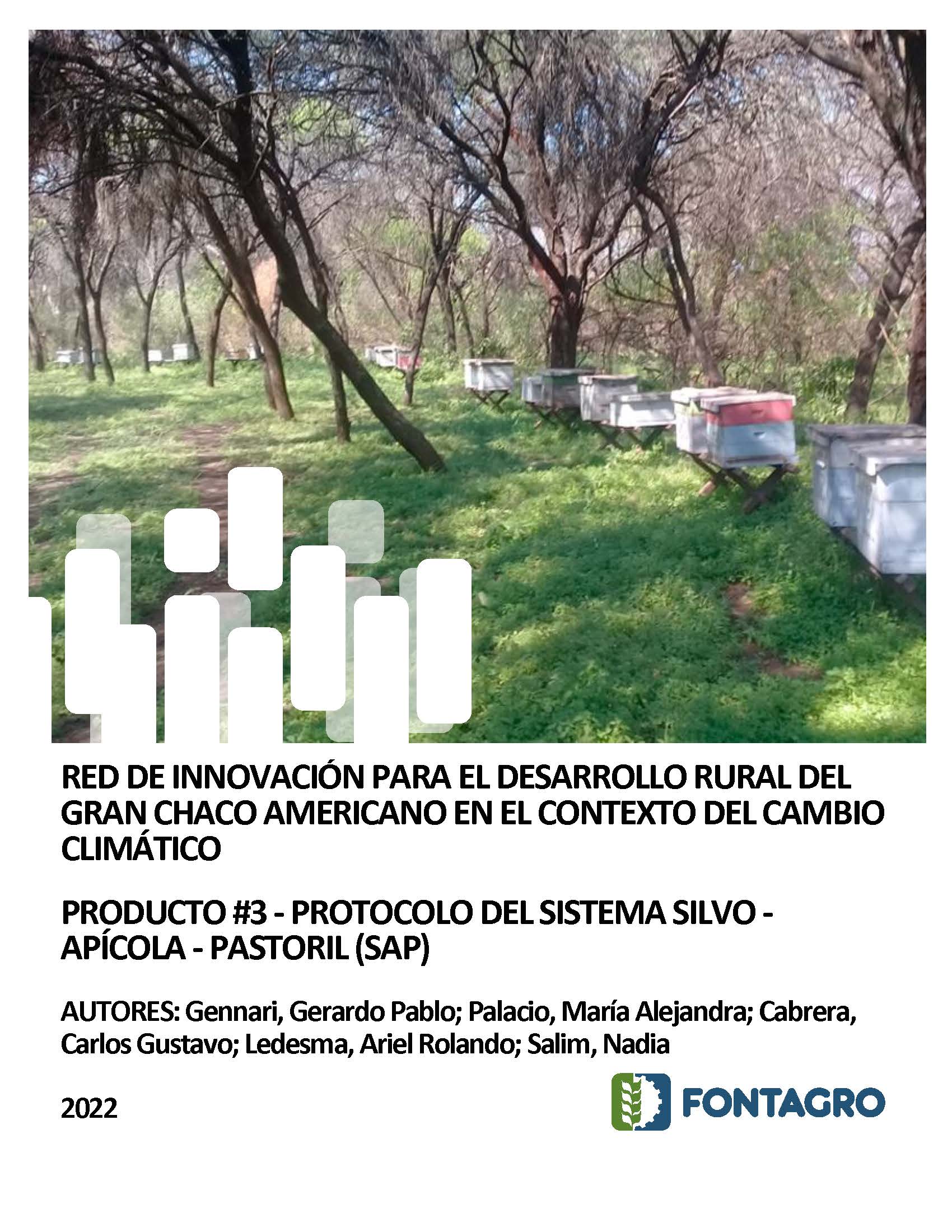Ver ítem
- xmlui.general.dspace_homeCentros Regionales y EEAsCentro Regional Tucumán - Santiago del EsteroEEA FamailláInformes técnicosxmlui.ArtifactBrowser.ItemViewer.trail
- Inicio
- Centros Regionales y EEAs
- Centro Regional Tucumán - Santiago del Estero
- EEA Famaillá
- Informes técnicos
- Ver ítem
Producto #3 - Protocolo del Sistema Silvo - Apícola - Pastoril (SAP).
Resumen
This document developed within the framework of the Innovation Network project for Rural Development of the Gran Chaco Americano in the Context of Climate Change - ref. ATN/RF-16112-RG, aims to be a tool where knowledge and recommended practices of three types of production present in the native forests of the Gran Chaco Americano converge: forestry, livestock and beekeeping. The combination of productions such as beekeeping, forestry and livestock have
[ver mas...]
This document developed within the framework of the Innovation Network project for Rural Development of the Gran Chaco Americano in the Context of Climate Change - ref. ATN/RF-16112-RG, aims to be a tool where knowledge and recommended practices of three types of production present in the native forests of the Gran Chaco Americano converge: forestry, livestock and beekeeping. The combination of productions such as beekeeping, forestry and livestock have the purpose of maximizing the use of radiant energy and minimizing soil erosion and loss of functions and fertility.
The silvo-apicultural pastoral or silvo-apicultural livestock management is a productive model where the production of the forest, beekeeping, forage and grazing of animals are simultaneously integrated into a management unit in a sustainable and respectful manner with the environment. Current production models propose a dilemma between agricultural, forestry, livestock or monoculture production as valid alternatives to develop production without taking into account those who wish to promote forestry, pastoral and beekeeping practices.
Beekeeping as a complementary activity and totally conjugable with any of the previously mentioned productions, is associated especially well in the Silvopastoral systems in the Gran Chaco Americano Region where the native forest predominates and takes advantage of resources in addition to providing ecosystem services such as pollination of different species. vegetables.
In preserved natural forest areas, agricultural systems are often involved where annual or perennial crops are incorporated, as well as pastures for cattle. Forest Management with Integrated Livestock (MBGI) proposes the use of the forest in an integral way that serves as an alternative for sustainable development in the face of changes in land use.
In this framework, forest conservation and livestock management are included together with beekeeping in the same productive matrix, allowing the integration of all components and taking advantage of the benefits that each one contributes to the system in general.
[Cerrar]
El Presente documento desarrollado, en el marco del proyecto Red de Innovación para el Desarrollo Rural del Gran Chaco Americano en el Contexto del Cambio Climático - ref. ATN/RF-16112-RG, pretende ser una herramienta donde confluyen los saberes y las prácticas recomendables de tres tipos de producciones presentes en los bosques nativos del Gran Chaco Americano: la silvicultura, la ganadería y la apicultura. La combinación de producciones como la apícola,
[ver mas...]
El Presente documento desarrollado, en el marco del proyecto Red de Innovación para el Desarrollo Rural del Gran Chaco Americano en el Contexto del Cambio Climático - ref. ATN/RF-16112-RG, pretende ser una herramienta donde confluyen los saberes y las prácticas recomendables de tres tipos de producciones presentes en los bosques nativos del Gran Chaco Americano: la silvicultura, la ganadería y la apicultura. La combinación de producciones como la apícola, forestal y la ganadera tienen la finalidad de maximizar el uso de la energía radiante y minimizar la erosión del suelo y pérdida de funciones y fertilidad.
El manejo silvo apícola pastoril o silvo apícola ganadero es un modelo productivo donde se integran en una unidad de manejo simultáneamente la producción del bosque, la apicultura, el forraje y el pastoreo de animales de manera sustentable y respetuosa con el ambiente. Los modelos productivos actuales proponen una disyuntiva entre producciones agrícolas, forestales, ganaderas o monocultivos como alternativas válidas para desarrollar una producción sin tener en cuenta a aquellos que desean promover las prácticas silvo pastoriles y apícolas.
La apicultura como actividad complementaria y totalmente conjugable con cualquiera de las producciones mencionadas previamente, se asocia especialmente bien en los sistemas Silvopastoriles en la Región del Gran Chaco Americano donde predomina el bosque nativo y aprovecha recursos además de aportar servicios ecosistémicos como la polinización de diferentes especies vegetales.
En las áreas de bosque natural preservadas, muchas veces se involucran sistemas agrícolas donde se incorporan cultivos anuales o perennes, así como pasturas para el ganado. El Manejo de Bosque con Ganadería Integrada (MBGI) propone el aprovechamiento del bosque de una manera integral que sirva como una alternativa de desarrollo sustentable frente a los cambios en el uso del suelo.
En este marco, la conservación del bosque y el manejo ganadero son incluidos junto con la apicultura en una misma matriz productiva, posibilitando la integración de todos los componentes y aprovechando los beneficios que cada uno aporta al sistema en general.
[Cerrar]

Fecha
2022
Editorial
INTA-Fondo Regional de Tecnología Agropecuaria (FONTAGRO)
Formato
pdf
Tipo de documento
informe técnico
Proyectos
(ver más)
Palabras Claves
Derechos de acceso
Abierto
 Excepto donde se diga explicitamente, este item se publica bajo la siguiente descripción: Creative Commons Attribution-NonCommercial-ShareAlike 2.5 Unported (CC BY-NC-SA 2.5)
Excepto donde se diga explicitamente, este item se publica bajo la siguiente descripción: Creative Commons Attribution-NonCommercial-ShareAlike 2.5 Unported (CC BY-NC-SA 2.5)


